Related Research Articles
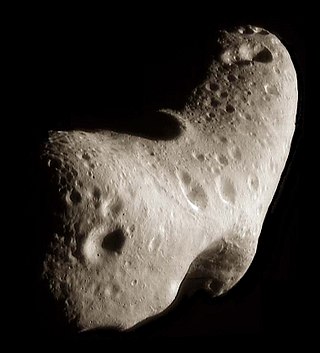
Eros, provisional designation 1898 DQ, is a stony asteroid of the Amor group and the first discovered and second-largest near-Earth object with an elongated shape and a mean diameter of approximately 16.8 kilometers. Visited by the NEAR Shoemaker space probe in 1998, it became the first asteroid ever studied from orbit around the asteroid.

Pallas is the second asteroid to have been discovered, after Ceres. It is believed to have a mineral composition similar to carbonaceous chondrite meteorites, like Ceres, though significantly less hydrated than Ceres. It is the third-largest asteroid in the Solar System by both volume and mass, and is a likely remnant protoplanet. It is 79% the mass of Vesta and 22% the mass of Ceres, constituting an estimated 7% of the mass of the asteroid belt. Its estimated volume is equivalent to a sphere 507 to 515 kilometers in diameter, 90–95% the volume of Vesta.
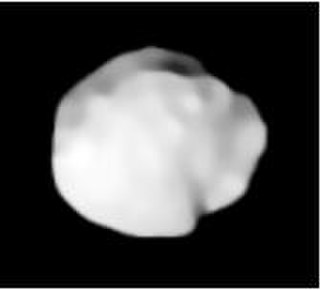
3 Juno is a large asteroid in the asteroid belt. Juno was the third asteroid discovered, in 1804, by German astronomer Karl Harding. It is one of the twenty largest asteroids and one of the two largest stony (S-type) asteroids, along with 15 Eunomia. It is estimated to contain 1% of the total mass of the asteroid belt.
In astronomy and celestial navigation, an ephemeris is a book with tables that gives the trajectory of naturally occurring astronomical objects as well as artificial satellites in the sky, i.e., the position over time. Historically, positions were given as printed tables of values, given at regular intervals of date and time. The calculation of these tables was one of the first applications of mechanical computers. Modern ephemerides are often provided in electronic form. However, printed ephemerides are still produced, as they are useful when computational devices are not available.
George Ogden Abell was an American educator. Teaching at UCLA, priorly he worked as a research astronomer, administrator, as a popularizer of science and of education, and as a skeptic. He earned his B.S. in 1951, his M.S. in 1952 and his Ph.D. in 1957, all from the California Institute of Technology. He was a Ph.D. student under Donald Osterbrock. His astronomical career began as a tour guide at the Griffith Observatory in Los Angeles. Abell made great contributions to astronomical knowledge which resulted from his work during and after the National Geographic Society - Palomar Observatory Sky Survey, especially concerning clusters of galaxies and planetary nebulae. A galaxy, an asteroid, a periodic comet, and an observatory are all named in his honor. His teaching career extended beyond the campus of UCLA to the high school student oriented Summer Science Program, and educational television. He not only taught about science but also about what is not science. He was an originating member of the Committee on Scientific Investigation of Claims of the Paranormal now known as the Committee for Skeptical Inquiry.

Yerkes Observatory is an astronomical observatory located in Williams Bay, Wisconsin, United States. The observatory was operated by the University of Chicago Department of Astronomy and Astrophysics from its founding in 1897 to 2018. Ownership was transferred to the non-profit Yerkes Future Foundation (YFF) in May 2020, which began restoration and renovation of the historic building and grounds. Re-opening for public tours and programming began May 27, 2022.

The Lick Observatory is an astronomical observatory owned and operated by the University of California. It is on the summit of Mount Hamilton, in the Diablo Range just east of San Jose, California, United States. The observatory is managed by the University of California Observatories, with headquarters on the University of California, Santa Cruz campus, where its scientific staff moved in the mid-1960s. It is named after James Lick.

The Paris Observatory, a research institution of the Paris Sciences et Lettres University, is the foremost astronomical observatory of France, and one of the largest astronomical centers in the world. Its historic building is on the Left Bank of the Seine in central Paris, but most of the staff work on a satellite campus in Meudon, a suburb southwest of Paris.

1620 Geographos, provisional designation 1951 RA, is a highly elongated, stony asteroid, near-Earth object and potentially hazardous asteroid of the Apollo group, with a mean-diameter of approximately 2.5 km (1.6 mi). It was discovered on 14 September 1951, by astronomers Albert George Wilson and Rudolph Minkowski at the Palomar Observatory in California, United States. The asteroid was named in honor of the National Geographic Society.
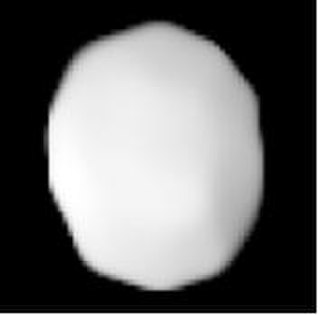
Davida is a large C-type asteroid. It is the one of the largest asteroids; approximately tied for 7th place, to within measurement uncertainties, and the 5th or 6th most massive. It was discovered by R. S. Dugan in 1903. Davida is named after David Peck Todd, an astronomy professor at Amherst College.

George A. Van Biesbroeck was a Belgian–American astronomer. He worked at observatories in Belgium, Germany and the United States. He specialized in the observation of double stars, asteroids and comets. He is notable for his long career as an observational astronomer.

Hygiea is a major asteroid and possible dwarf planet located in the main asteroid belt. With a diameter of 434 kilometres (270 mi) and a mass estimated to be 3% of the total mass of the belt, it is the fourth-largest asteroid in the Solar System by both volume and mass. In some spectral classifications it is the largest of the dark C-type asteroids with a carbonaceous surface, whereas in others it is second after 1 Ceres.
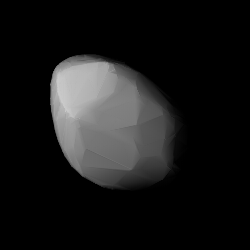
1685 Toro is an asteroid and near-Earth object of the Apollo group on an eccentric orbit. It was discovered on 17 July 1948, by American astronomer Carl Wirtanen at Lick Observatory on Mount Hamilton, California. The stony S-type asteroid has a rotation period of 10.2 hours and measures approximately 4 kilometers in diameter. It is named for Betulia Toro Herrick, wife of astronomer Samuel Herrick.
Anderson Mesa Station is an astronomical observatory established in 1959 as a dark-sky observing site for Lowell Observatory. It is located at Anderson Mesa in Coconino County, Arizona, about 12 miles southeast of Lowell's main campus on Mars Hill in Flagstaff, Arizona.
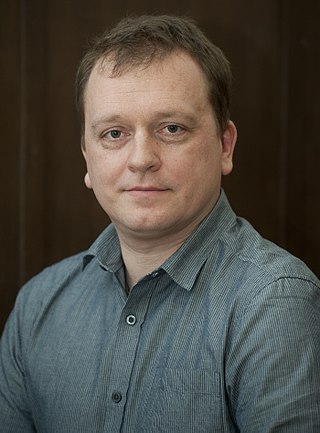
Krisztián Sárneczky is a Hungarian teacher of geography and prolific discoverer of minor planets and supernovae, researching at Konkoly Observatory in Budapest, Hungary. He is a board member of the Hungarian Astronomical Association (HAA) and member of the American Association of Variable Star Observers, leader of the Comet Section of the HAA, and is a contributor in the editorial work of Hungarian Astronomical Almanach.
Elena Vladimirovna Pitjeva is a Russian astronomer working at the Institute of Applied Astronomy, Russian Academy of Sciences, St. Petersburg. She has published over 100 articles, as listed in Google Scholar and the Astrophysics Data System in the field of solar system dynamics and celestial mechanics.

Nicholas B. Suntzeff is an American University Distinguished Professor and holds the Mitchell/Heep/Munnerlyn Chair of Observational Astronomy in the Department of Physics & Astronomy at Texas A&M University where he is Director of the Astronomy Program. He is an observational astronomer specializing in cosmology, supernovae, stellar populations, and astronomical instrumentation. With Brian Schmidt he founded the High-z Supernova Search Team, which was honored with the Nobel Prize in Physics in 2011 to Schmidt and Adam Riess.

(137108) 1999 AN10 is a kilometer-length near-Earth asteroid and potentially hazardous asteroid of the Apollo group. It was discovered by LINEAR on 13 January 1999.

Gerard Theodore van Belle is an American astronomer. He is an expert in optical astronomical interferometry.
A fundamental ephemeris of the Solar System is a model of the objects of the system in space, with all of their positions and motions accurately represented. It is intended to be a high-precision primary reference for prediction and observation of those positions and motions, and which provides a basis for further refinement of the model. It is generally not intended to cover the entire life of the Solar System; usually a short-duration time span, perhaps a few centuries, is represented to high accuracy. Some long ephemerides cover several millennia to medium accuracy.
References
- 1 2 Hilton, James L. (September 5, 2001). "Curriculum Vita". Archived from the original on 2006-10-02. Retrieved 2007-02-18.
- ↑ Hilton, James L. (February 1999). "US Naval Observatory Ephemerides of the Largest Asteroids". Astronomical Journal. 117 (2): 1077–1086. Bibcode:1999AJ....117.1077H. doi: 10.1086/300728 . Archived from the original on 2011-07-23. Retrieved 2007-09-06.